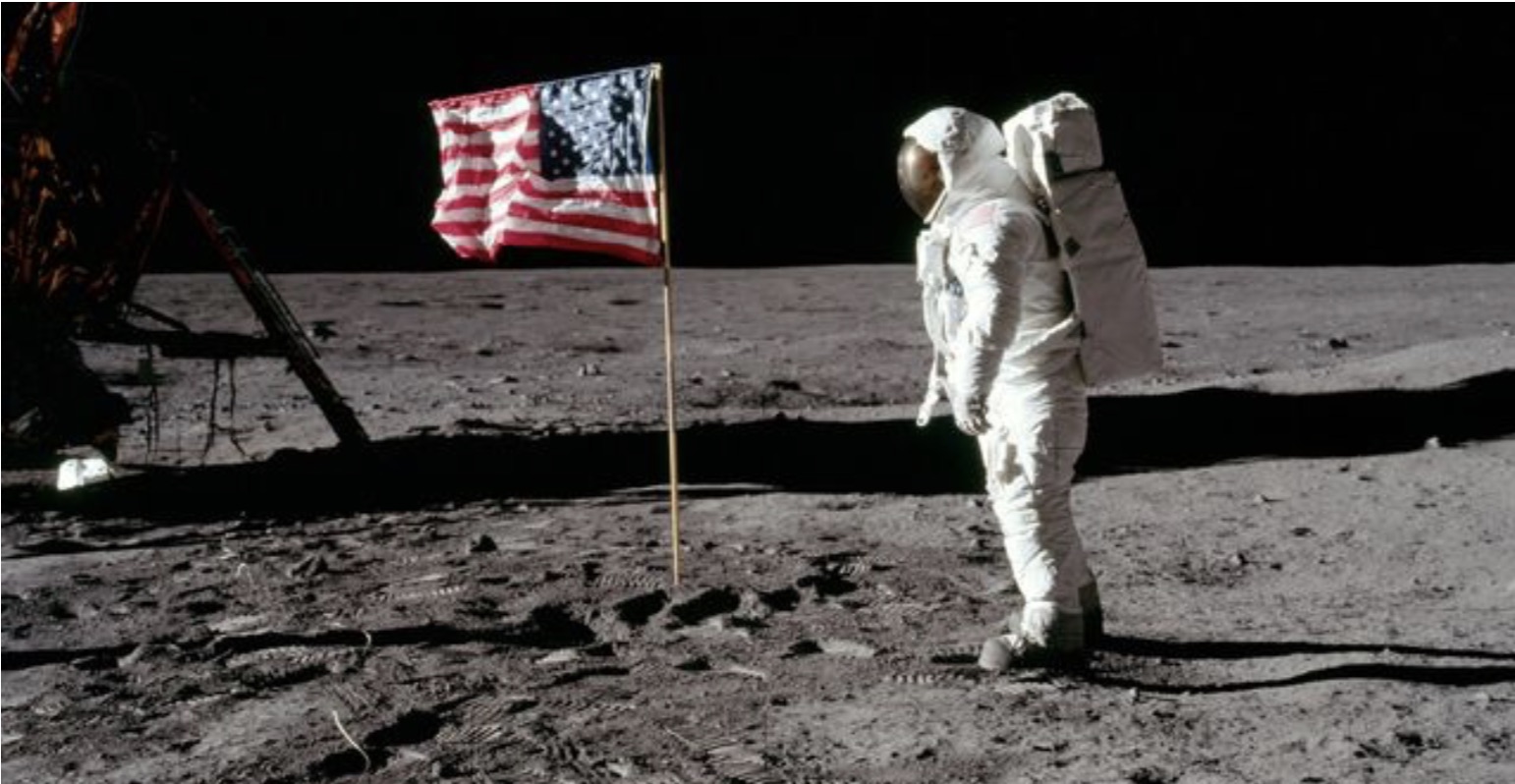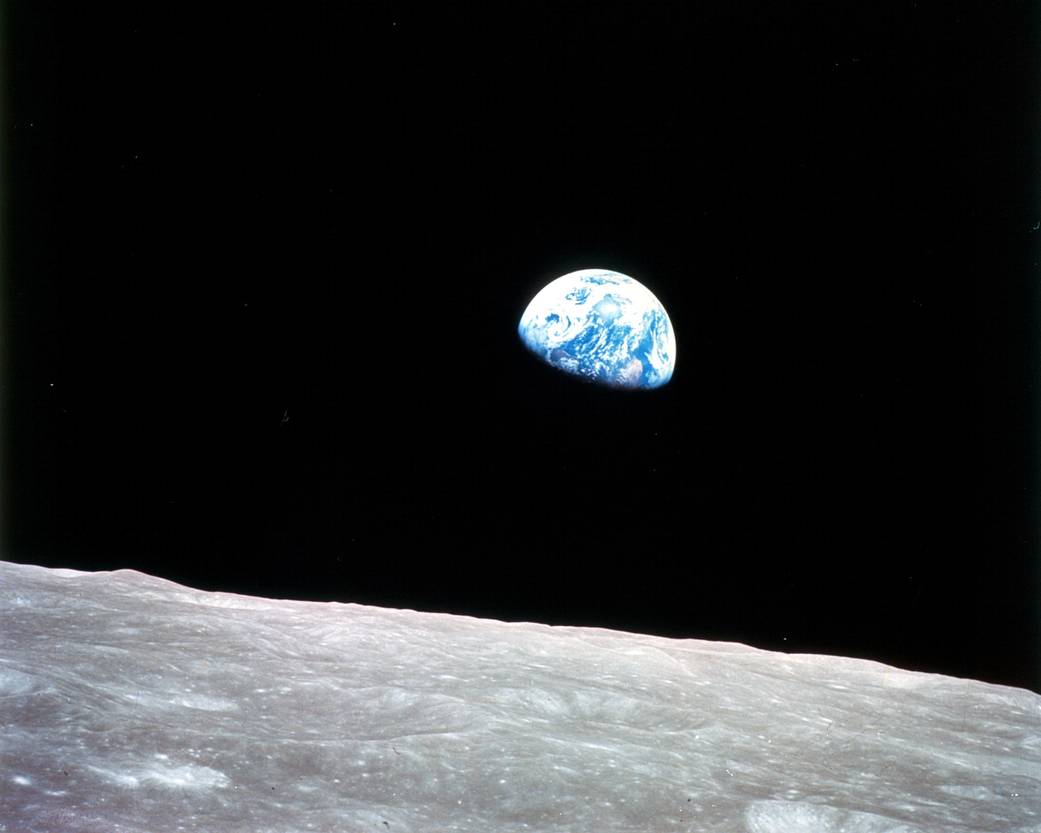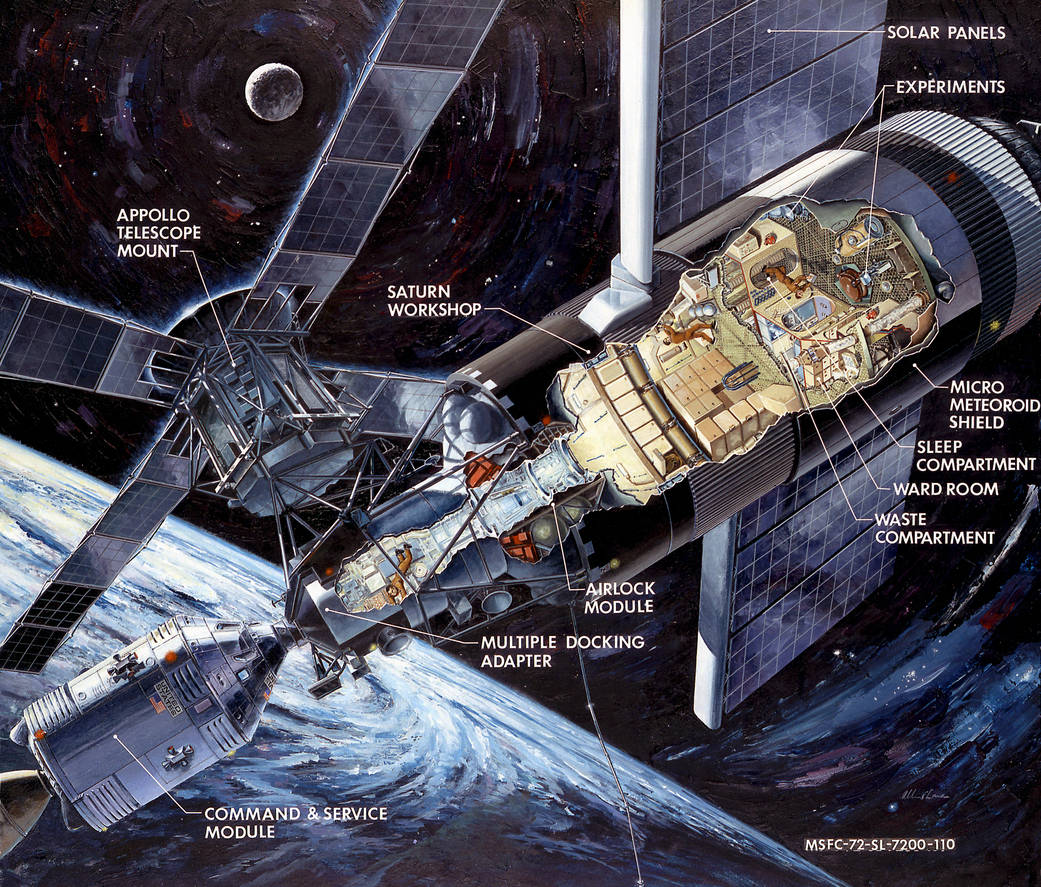Beyond Apollo 11: U-M ECE’s role in advancing space exploration
For the 50th anniversary of the Apollo 11 moon landing, U-M ECE takes a look back – and a look forward – to how our professors, students, and alums have made their mark on the field.

 Enlarge
Enlarge
50 years ago, a new era of exploration dawned as astronauts Neil Armstrong and Buzz Aldrin became the first to ever walk on the moon. It was an achievement that united the world, if only for a few hours, as everyone watched humanity do something long thought impossible. Over the past half century, the exploration of space has continued to fascinate people worldwide, including many of our professors who’ve contributed much to the field.
SPACE TRAVEL: MAKE IT SO
“Watching the landing was as exciting for me as it was for everyone else, maybe more so because I knew how much was behind the achievement,” says ECE Prof. Anthony England, Dean of the College of Engineering and Computer Science at U-M Dearborn and former NASA astronaut who worked on several of the Apollo and shuttle missions.
If you watched the film Apollo 13, you have already seen England at work. He helped write the procedure to build the CO2 scrubber that enabled the astronauts to return safely to Earth – the scene in the movie where the team had to figure out to fit a square peg in a round hole, essentially.
For their extraordinary work, England and the rest of the team received the President’s Medal of Freedom in 1970. While England’s opportunity to fly to the Moon was lost when Apollos 18 through 20 were cancelled, he did fly on Space Shuttle Challenger in the summer of 1985. His mission focused upon solar astronomy and plasma physics.
“We were in a high inclination orbit, and you could see the aurora over Antarctica standing up as a green curtain with waves on the front of it. This was in early August during the Perseid showers, so while you’re watching the aurora, you’re seeing shooting stars underneath you, below you,” England says. “It’s pretty spectacular to see the Earth that way.”

 Enlarge
Enlarge
England’s research at U-M concerned modeling processes that occur in the soil, vegetation, or snow to inform weather and climate models, which helps predict patterns in climate change. He also served as head of U-M’s Microwave Geophysics Group, which does geophysical remote sensing. However, he still feels a great passion for the final frontier, and hopes that while the moon landing defined space exploration for the last century, this century will continue to see pioneering achievements that take us to neighboring planets and beyond.
“I hope we quickly answer the questions and establish the confidence that will allow us to press on to Mars – a far more interesting object than our Moon,” England says.
We were in a high inclination orbit, and you could see the aurora over Antarctica standing up as a green curtain with waves on the front of it. It's pretty spectacular to see the Earth that way.
Prof. Anthony England
England isn’t the only one who concerns himself with space travel. Prof. Brian Gilchrist, the Director of the Space Physics Research Lab and the XTRM labs, has spent much of his career looking to advance spacecraft technology. One of his projects, in partnership with NASA and other universities explores the possibility of using thin cables between spacecraft in space orbit as a means of pushing and pulling against the Earth’s magnetic field.
These cables, known as space electrodynamic (ED) tethers, would be anchored to orbiting satellites. The tether would be an insulated conductive wire that uses the Earth’s magnetic field to automatically convert kinetic orbital energy in to electrical energy that can drive current through the tether (drag thrust) or uses other energy sources such as solar to drive current in the tether that pushes back against the magnetic field (propulsive thrust) moving the spacecraft either up, down, or sideways. This would solve a major issue associated with long-term space travel around planets with magnetic fields: propellant.

 Enlarge
Enlarge
Propellant is heavy to get into space and requires a lot of storage for long-term travel, which limits the design possibilities of spacecraft. What’s more, there are no stops on the way to Mars for you to conveniently pull over and top-up should you start to run low. Using space tethers could minimize or eliminate all-together the amount of propellant needed once the craft enters space orbit, and it could help keep space stations in orbit. Propulsion and power generation could be made possible in space around planets with a magnetic field and an ionosphere. The tethers could then be used on spacecraft, including space stations, to make-up for atmospheric drag or move them around continuously.
While tethers are one option, another option for deep space travel is to mine the needed resources. Alum Hannah Goldberg (BSE MSE EE 2003 2004) was a Senior Systems Engineer at Planetary Resources, Inc., a company that believes asteroids could function as interplanetary gas stations.
Asteroids contain water, often separated into hydrogen and oxygen, which is a typical propellant for spacecraft. For extended Deep Space travel, you can’t possibly carry enough water from Earth – the ship would never get off the ground. The benefit of asteroids is that they’re abundant – over 1,500 are easier to reach than the Moon – so you wouldn’t have to travel so far to get access to more fuel.
Goldberg helped further the company’s goal is to send up small unmanned robotic spacecraft to mine the water and any precious metals that may also be on the asteroids, such as platinum. The next step, using the water as gasoline for larger spacecraft, is years if not decades down the road.
To some it seems crazy – but to quote EECS alumnus and company investor Larry Page, Planetary Resources simply has “a healthy disregard for the impossible.” The company is run by visionaries and entrepreneurs involved in a high-risk field that they believe can revolutionize the future of humans in space.
Goldberg is currently a senior systems engineer at GomSpace, a commercial provider of Cubesat components, platforms, and solutions. She serves at the technical lead in the development of a constellation of communications satellites.
SPATIAL ANOMALIES: THE GREAT MYSTERIES
With the help of the T-cubed laser and HERCULES, housed at the Center for Ultrafast Optical Science, and other external facilities such as the OMEGA EP laser at the Laboratory for Laser Energetics, Prof. Louise Willingale works to deepen our understanding of some of the most complex and awe-inspiring phenomena in the galaxy.

 Enlarge
Enlarge
Willingale uses laser light to produce plasma. Plasma is the fourth state of matter that consists of an ionized gas and contains electrons and ions that respond to electromagnetic fields. Once she’s produced the plasma, she’s able to study processes like magnetic reconnection, which is the breaking and reconnecting of oppositely directed magnetic field lines. This process is central to some of the most awe-inspiring and spectacular spatial anomalies, including solar flares and the famous Northern Lights, but it can also inform us about many other kinds of spatial phenomena, such as the structure of pulsar jets and effects associated with neutron stars.
“It’s obviously not possible to recreate a neutron star in a space of a few microns,” Willingale says, “so our idea is to recreate some of the physical processes but on a tiny scale. We can then make inferences about the dominant processes happening much further away and on a much larger scale.”
Like Willingale, alum Dr. Katie Bouman (BSE EE 2011) has helped shed light on the darkest mysteries in the universe. Bouman was famously part of the international team of over 200 scientists who photographed a black hole for the very first time.

 Enlarge
Enlarge
While enrolled as a grad student at MIT, Bouman developed a crucial algorithm that helped devise the imaging method she would ultimately use for the black hole project. She spent three years directing the verification of images and the selection of image parameters to filter out the noise and give us a good look at the literal biggest secret in the galaxy: what a black hole looks like.
Black holes have mystified scientists for decades. Despite its name, a black hole isn’t a hole at all – it’s a pocket of space full of a massive amount of densely packed matter. Black holes take up a relatively little amount of space considering their ridiculous amount of mass, so they ultimately warp the very fabric of space-time. They are the universe’s ultimate quicksand, from which not even light can escape. It’s like trying to photograph a ghost.
It took two years, eight radio observatories on six mountains and four continents, and a network of radio telescopes called the Event Horizon Telescope (EHT), but we now have seen the impossible.
“Pressing ‘go’ on a computer program I had written and immediately seeing a ring come into focus for the first time was amazing and exhilarating,” Bouman said to Newsweek. “We had prepared for years, but even so it was too easy! It was an unforgettable moment.”
Bouman returned to U-M last year and gave a preview of her work, including a first look at the black hole image itself.
“I was struck by the enormity of the project and how cool it is to ‘see’ the invisible,” says Mingyan Liu, the Peter and Evelyn Fuss Chair of ECE, who met with Bouman while she was here. “What impressed me most is the unique impact of what she was doing in this application context.”
The image that Bouman helped create provides confirmation of more than a century of theory and will open up entirely new avenues of study.
PIONEERS IN SPACE
When people first ventured into space, we gained not only an iconic image of the Earth but an entirely new platform for research. Specialized tools needed to be developed, and professors Fawaaz Ulaby and Kamal Sarabandi were at the forefront of this innovation.
Ulaby, the Emmett Leith Distinguished University Professor of EECS and Arthur F. Thurnau Professor, pioneered remote sensing systems that now fly aboard satellites operated by NASA as well as the European, Canadian, and Japanese space agencies. Specifically, he designed the first radar to ever fly in space. The home of his radar system was aboard Skylab, America’s first space station. Ulaby went on to receive the NASA/Department of the Interior William Pecora Award for shaping the direction of the space program in microwave remote sensing.

 Enlarge
Enlarge
Sarabandi, the Rufus S. Teesdale Professor of Engineering and Director of the Radiation Laboratory, has been involved in mission planning and experimentation for many of NASA’s space-borne remote sensing imaging radars including NASA’s 1994 Shuttle Imaging Radar (SIR-C), 2000 Shuttle Radar Topography Mission (SRTM), and 2015 Soil Moisture Active Passive (SMAP). The active and passive polarimetric radar calibrators and external calibration techniques developed for these missions have become the standard approach used worldwide. In addition to his outstanding contributions, he has also served as a member of the NASA Advisory Council.
THE FUTURE
While the past 50 years have seen a lot of advancements in space exploration, it’s the next generation who hope to bring about the next Giant Leap for Mankind. Undergrad Havel Liu is working on a project to design a constellation of miniature satellites, called “CubeSats,” which would revolutionize global communication. If successful, the project could be a blueprint for future interplanetary communication arrays.

 Enlarge
Enlarge
“Say we have a colony on Mars – you could have a similar satellite swarm surrounding Mars,” Liu says. “Then you could actually pass messages back and forth to colonists and astronauts when they have stronger radios and antennas.”
The Michigan Mars Rover team is devoted to advancing vehicles for the exploration of other planets. Their rover can function over difficult, uneven terrain, operate complicated tasks with a robotic arm, and autonomously localize and navigate the area. Most importantly, their rover collects soil samples to test for signs of life.
“There’s a lot that we don’t know about the material – and the extraterrestrial material – of other planets,” says Michelle Gehner, a sophomore in EE who will serve as president of MRover this coming year. “That’s why I really wanted to learn about how to engineer better ways to create instruments that will help us explore other worlds.”

 Enlarge
Enlarge
“There’s a romance to space exploration,” says Karthik Urs, a senior in CE and ME who’s been a member of MRover since he was a sophomore. “But I also love the engineering aspects. Space poses challenges that are completely different than on earth that require some very clever engineering solutions.”
MRover had their best ever finish this year at the University Rover Challenge, held at the Mars Desert Research Station in the Utah Desert. MRover placed 4th in the U.S. and 7th overall. The Challenge is hosted by The Mars Society, the largest advocacy group for the exploration and settlement of Mars – a dream that becomes more and more relevant every day, for a mission to Mars is on the horizon.
As satellites journey beyond our solar system showing us a potential route for the next generations, the legacy of the Apollo 11 mission continues to live on. And in the spirit of that achievement, whether the journey be toward Mars or the second star to the right and straight on till morning, U-M ECE professors, students, and alums will continue to boldly go where no one has gone before.
 MENU
MENU